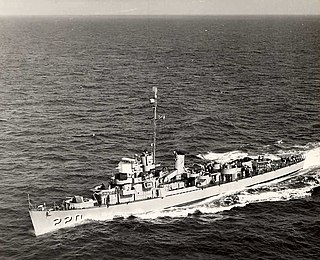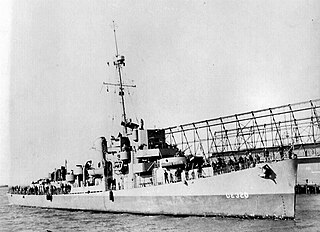
USS Herndon (DD-638), a Gleaves-class destroyer, was the second ship of the United States Navy to be named for Commander William Lewis Herndon.

USS Finch (DE-328) was an Edsall-class destroyer escort in the service of the United States Navy from 1943 to 1946 and from 1956 to 1969. From 1951 to 1954, she was loaned to the United States Coast Guard where she served as USCGC Finch (WDE-428). She was scrapped in 1974.

USS Forrest (DD-461/DMS-24), a Gleaves-class destroyer, was the only ship of the United States Navy to be named for Lieutenant Dulany Forrest, an officer who served during the War of 1812.

USS Holt (DE-706) was a Rudderow-class destroyer escort of the United States Navy. She was named after William Mack Holt.
USS Earl V. Johnson (DE-702) was a Buckley-class destroyer escort of the United States Navy, named in honor of Lieutenant (j.g.) Earl V. Johnson (1913–42), a naval aviator who was awarded the Navy Cross posthumously for "extraordinary heroism" during the Battle of the Coral Sea.
USS Chickadee (AM-59) was an Auk-class minesweeper of the United States Navy, named after the Chickadee, a family of small passerine birds which appear in North America and Africa.

USS Gantner (DE-60/APD-42), a Buckley-class destroyer escort of the United States Navy, was named in honor of Boatswain's Mate Samuel Merritt Gantner (1919-1941), who was killed in action during the Japanese attack on the Hawaiian Islands.

USS Hopping (DE-155) was a Buckley-class destroyer escort in service with the United States Navy from 1943 to 1947. In 1944, she was converted to a Charles Lawrence-class high speed transport and redesignated "APD-51". She was sold for scrap in 1966.
USS Coolbaugh (DE-217), a Buckley-class destroyer escort of the United States Navy, was named in honor of Lieutenant Walter W. Coolbaugh (1914-1942), who was killed in an aircraft accident on 19 December 1942. He was a recipient of the Navy Cross.

USS Francis M. Robinson (DE-220), a Buckley-class destroyer escort of the United States Navy, was named in honor of Commander Francis M. Robinson (1883-1942), who was a recipient of the Navy Cross.
USS Fowler (DE-222), a Buckley-class destroyer escort of the United States Navy, was named in honor of Lieutenant Robert L. Fowler (1919-1942), who was killed in action, while serving aboard the destroyer Duncan (DD-485) during the Battle of Cape Esperance on the night of 11–12 October 1942. He was posthumously awarded the Navy Cross.

USS Savage (DE-386) was an Edsall-class destroyer escort built for the United States Navy during World War II.

USS Menges (DE-320) was an Edsall-class destroyer escort built for the United States Navy during World War II. Named for Ensign Herbert Hugo Menges, she was the first U.S. naval vessel to bear the name.

USS Berkeley County (LST-279) was an LST-1-class tank landing ship built for the United States Navy during World War II. Named for counties in South Carolina and West Virginia, she was the only U.S. Naval vessel to bear the name.

USS Whitman (DE-24) was an Evarts-class destroyer escort constructed for the United States Navy during World War II. It was promptly sent off into the Pacific Ocean to protect convoys and other ships from Japanese submarines and fighter aircraft. By the end of the war, when she returned to the United States, she had proudly accumulated four battle stars.
The second USS Dempsey (DE-26) was an Evarts-class destroyer escort constructed for the United States Navy during World War II. She was promptly sent off into the Pacific Ocean to protect convoys and other ships from Japanese submarines and fighter aircraft. By the end of the ship's World War II service career, when she returned to the United States, she had accumulated three battle stars.

USS Dionne (DE-261) was an Evarts-class destroyer escort of the United States Navy during World War II. She was sent off into the Pacific Ocean to protect convoys and other ships from Japanese submarines and fighter aircraft. She performed escort and antisubmarine operations in dangerous battle areas and returned home with six battle stars, a high number for a ship of her type.

USS Koiner (DE-331) was an Edsall-class destroyer escort built for the U.S. Navy during World War II. She served in the Atlantic Ocean and the Pacific Ocean and provided destroyer escort protection against submarine and air attack for Navy vessels and convoys. Post-war, she was loaned to the U.S. Coast Guard, and also reclassified as a radar picket ship.

USS Ringness (APD-100) was a Crosley-class high speed transport that served in the United States Navy from 1944 to 1946. After spending 29 years in reserve, she was sold for scrapping in 1975.

USS Gherardi (DD-637/DMS-30), a Gleaves-class destroyer, is the only ship of the United States Navy to be named for Rear Admiral Bancroft Gherardi.















